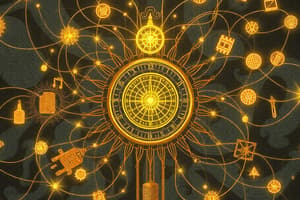Podcast
Questions and Answers
¿Qué proceso implica la electrificación en el contexto de sistemas de transporte?
¿Qué proceso implica la electrificación en el contexto de sistemas de transporte?
- Convertir métodos tradicionales de transporte en sistemas eléctricos. (correct)
- Mejorar la eficiencia de los motores de combustión interna.
- Eliminar por completo el transporte público.
- Implementar métodos de transporte más contaminantes.
¿De qué están compuestos los campos electromagnéticos?
¿De qué están compuestos los campos electromagnéticos?
- Campos magnéticos generados por partículas no cargadas.
- Campos eléctricos y magnéticos que interactúan entre sí. (correct)
- Campos eléctricos que actúan sobre partículas neutras.
- Campos gravitacionales y magnéticos que nunca se relacionan.
¿Qué genera un campo magnético en el contexto de motores eléctricos?
¿Qué genera un campo magnético en el contexto de motores eléctricos?
- Una corriente eléctrica que fluye a través de un alambre. (correct)
- La presencia de partículas neutras en una bobina.
- La ausencia de energía eléctrica en un sistema.
- El movimiento de partículas neutras en una bobina.
¿Qué tipo de partículas da origen al campo eléctrico en un sistema electromagnético?
¿Qué tipo de partículas da origen al campo eléctrico en un sistema electromagnético?
¿Qué tipo de energía convierten los motores eléctricos en energía mecánica?
¿Qué tipo de energía convierten los motores eléctricos en energía mecánica?
¿Qué tipo de motores existen primarily según el texto?
¿Qué tipo de motores existen primarily según el texto?
¿Qué aspecto influye en la elección entre motores DC y AC según el texto?
¿Qué aspecto influye en la elección entre motores DC y AC según el texto?
¿Por qué es importante comprender los principios de electromagnetismo según el texto?
¿Por qué es importante comprender los principios de electromagnetismo según el texto?
¿Qué papel juega el campo magnético en la rotación del rotor?
¿Qué papel juega el campo magnético en la rotación del rotor?
¿Cómo se puede resumir el papel del electromagnetismo en la electrificación según el texto?
¿Cómo se puede resumir el papel del electromagnetismo en la electrificación según el texto?
Flashcards are hidden until you start studying
Study Notes
Electrification
Electrification is the process of converting traditional transportation methods into electrically operated systems. This includes vehicles like cars, buses, trains, ships, and aircrafts. While there is much information available online about various aspects of electrification, this article focuses on the fundamental concept of electromagnetism that plays a crucial role in understanding how electric motors work.
Electromagnetic Field Theory
An electromagnetic field consists of electric and magnetic fields, which interact with each other. These two forces arise from charged particles such as electrons, protons, and their antiparticles. The electric field is a force field that acts on charged particles, while the magnetic field is a force field that acts on moving charged particles.
In the context of electric motors, which are essential components in electrified transportation, the electromagnetic field is created by an electric current flowing through a wire. This current is in turn due to the movement of electrons in the wire. When an electrically charged particle is accelerated, it creates an electromagnetic field.
Electric Motors
Electric motors convert electrical energy into mechanical energy. They consist of a coil of wire wound around a soft iron core, known as the stator, and a second coil wound around a rotor that rotates within the stator. When an electric current is passed through the coil on the stator, it generates a magnetic field. This magnetic field interacts with the magnetic field of the rotor, causing it to rotate.
There are two primary types of electric motors: DC (Direct Current) motors and AC (Alternating Current) motors. The choice between these two types depends on the specific requirements of the application, such as the speed at which the motor needs to rotate and the amount of torque it needs to generate.
Applications of Electromagnetism in Electrification
The principles of electromagnetism play a vital role in the functioning of electric motors, which are central to the operation of electrified transportation systems. By understanding these principles, we can gain a deeper appreciation for the technology that powers our electric cars, buses, trains, ships, and aircrafts.
In conclusion, electrification is not just about replacing fossil fuels with electricity, but also about harnessing the power of electromagnetism to create efficient and sustainable transportation systems. As we continue to explore new ways to electrify transportation, the fundamental principles of electromagnetism will continue to be essential for the development of these technologies.
Studying That Suits You
Use AI to generate personalized quizzes and flashcards to suit your learning preferences.




